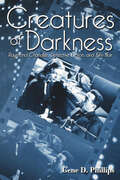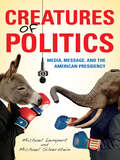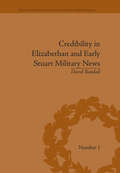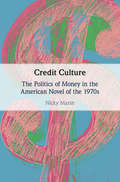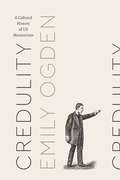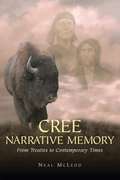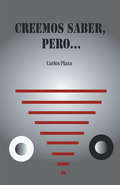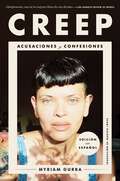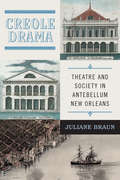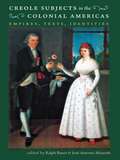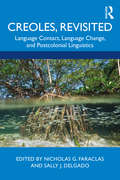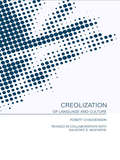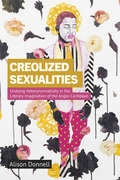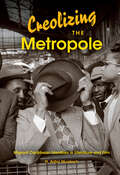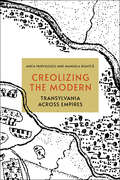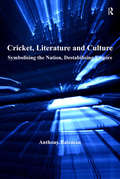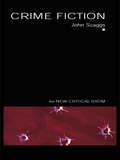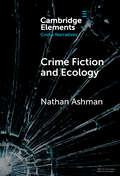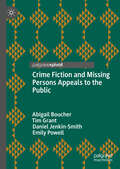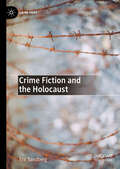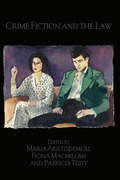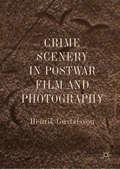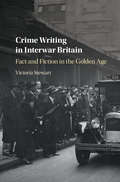- Table View
- List View
Creatures of Darkness: Raymond Chandler, Detective Fiction, and Film Noir
by Gene D. Phillips“[An] exhaustively researched survey of Raymond Chandler’s thorny relationship with Hollywood during the classic period of film noir.” —Alain Silver, film producer and authorRaymond Chandler’s seven novels, including The Big Sleep (1939) and The Long Goodbye (1953), with their pessimism and grim realism, had a direct influence on the emergence of film noir. Chandler worked to give his crime novels the flavor of his adopted city, Los Angeles, which was still something of a frontier town, rife with corruption and lawlessness. In addition to novels, Chandler wrote short stories and penned the screenplays for several films, including Double Indemnity (1944) and Strangers on a Train (1951). His work with Billy Wilder and Alfred Hitchcock on these projects was fraught with the difficulties of collaboration between established directors and an author who disliked having to edit his writing on demand.Creatures of Darkness is the first major biocritical study of Chandler in twenty years. Gene Phillips explores Chandler’s unpublished script for Lady in the Lake, examines the process of adaptation of the novel Strangers on a Train, discusses the merits of the unproduced screenplay for Playback, and compares Howard Hawks’s director’s cut of The Big Sleep with the version shown in theaters. Through interviews he conducted with Wilder, Hitchcock, Hawks, and Edward Dmytryk over the past several decades, Phillips provides deeper insight into Chandler’s sometimes difficult personality.Chandler’s wisecracking private eye, Philip Marlowe, has spawned a thousand imitations. Creatures of Darkness lucidly explains the author’s dramatic impact on both the literary and cinematic worlds, demonstrating the immeasurable debt that both detective fiction and the neo-noir films of today owe to Chandler’s stark vision.
Creatures of Politics: Media, Message, and the American Presidency
by Michael Silverstein Michael LempertThis analysis of campaign messaging and image-making is “a fascinating read and an illuminating look into the complex realm of political rhetoric” (Publishers Weekly).It’s a common complaint that a presidential candidate’s style matters more than substance and that the issues have been eclipsed by mass-media-fueled obsession with a candidate’s every slip, gaffe, and peccadillo. This book explores political communication in American presidential politics, focusing on what insiders call “message.”Message, Michael Lempert and Michael Silverstein argue, is not simply an individual’s positions on the issues but the craft used to fashion the creature the public sees as the candidate. Lempert and Silverstein examine some of the revelatory moments in debates, political ads, interviews, speeches, and talk shows to explain how these political creations come to have a life of their own. From the pandering “Flip-Flopper” to the self-reliant “Maverick,” the authors demonstrate how these figures are fashioned out of the verbal, gestural, sartorial, behavioral—as well as linguistic—matter that comprises political communication.“This book captures better than any other the way ‘messaging’ works . . . their lively account of the culture of presidential communication remains sensitive to both the comedy and the seriousness of its subject.” —Michael Warner, Yale University
Credibility in Elizabethan and Early Stuart Military News (Political and Popular Culture in the Early Modern Period #1)
by David RandallElizabethan and early Stuart England saw the prevailing medium for transmitting military news shift from public ritual, through private letters, to public newspapers. This study is based on an examination of hundreds of manuscript news letters, printed pamphlets and corantos, and news diaries which are in holdings in the US and the UK.
Credit Culture: The Politics of Money in the American Novel of the 1970s
by Nicky MarshThis book offers a new reading of the relationship between money, culture and literature in America in the 1970s. The gold standard ended at the start of this decade, a moment which is routinely treated as a catalyst for the era of postmodern abstraction. This book provides an alternative narrative, one that traces the racialized and gendered histories of credit offered by the intertextual narratives of writers such as E.L Doctorow, Toni Morrison, Marilyn French, William Gaddis, Thomas Pynchon and Don De Lillo. It argues that money in the 1970s is better read through a narrative of political consolidation than formal rupture as these histories foreground the closing down, rather than opening up, of serious debates about what American money should be and who it should serve. These novels and this moment remain important because they alert us to imagine the alternative histories of credit that were imaginatively proposed but never realized.
Credulity: A Cultural History of US Mesmerism (Class 200: New Studies in Religion)
by Emily OgdenFrom the 1830s to the Civil War, Americans could be found putting each other into trances for fun and profit in parlors, on stage, and in medical consulting rooms. They were performing mesmerism. Surprisingly central to literature and culture of the period, mesmerism embraced a variety of phenomena, including mind control, spirit travel, and clairvoyance. Although it had been debunked by Benjamin Franklin in late eighteenth-century France, the practice nonetheless enjoyed a decades-long resurgence in the United States. Emily Ogden here offers the first comprehensive account of those boom years. Credulity tells the fascinating story of mesmerism’s spread from the plantations of the French Antilles to the textile factory cities of 1830s New England. As it proliferated along the Eastern seaboard, this occult movement attracted attention from Ralph Waldo Emerson’s circle and ignited the nineteenth-century equivalent of flame wars in the major newspapers. But mesmerism was not simply the last gasp of magic in modern times. Far from being magicians themselves, mesmerists claimed to provide the first rational means of manipulating the credulous human tendencies that had underwritten past superstitions. Now, rather than propping up the powers of oracles and false gods, these tendencies served modern ends such as labor supervision, education, and mediated communication. Neither an atavistic throwback nor a radical alternative, mesmerism was part and parcel of the modern. Credulity offers us a new way of understanding the place of enchantment in secularizing America.
Cree Narrative Memory: From Treaties To Contemporary Times
by Neal McLeodNeal McLeod examines the history of the nêhiyawak (Cree People) of western Canada from the massive upheavals of the 1870s and the reserve period to the vibrant cultural and political rebirth of contemporary times. Central to the text are the narratives of McLeod's family, which give first hand examples of the tenacity and resiliency of the human spirit while providing a rubric for reinterpreting the history of Indigenous people, drawing on Cree worldviews and Cree narrative structures. <p><p> In a readable style augmented with extensive use of the Cree language throughout, McLeod draws heavily on original research, the methodology of which could serve as a template for those doing similar work. While the book is based on the Cree experience of the Canadian prairies, its message and methodology are applicable to all Indigenous societies.
Creemos saber, pero...
by Carlos PlazaContinuamos narrando historias para el entretenimiento de uds., en este caso, en el libro que tienen en sus manos se narran las historias Triángulos amigos y la fenomenal No sabemos nada. Esta última está vista siempre desde el punto de vista del autor, que no tiene porqué coincidir con la tuya, amable lector. En la primera se narra un encuentro ocasional con unos amigos muy especiales, con unas noticias espectaculares y no menos especiales, aunque por algunos motivos no llegan a dárselas a nuestro protagonista. Respecto a a nuestra segunda historia he de decir que; todos sabemos lo que pasa cuando fallecemos: lloros, lamentos, ayes y demás... Además, nuestro cuerpo físico empieza a desintegrarse en su eterno reposo. Pero lo que no sabemos es lo que sucede con nuestra mente en esos momentos tan temidos por algunos. Esta narración trata de explicarlo, y claro, ustedes pensarán que se trata de una historia ficticia, pero, ¿y si no lo fuese?...
Creep \ Creep (Spanish edition): Acusaciones y confesiones
by Myriam GurbaDe la aclamada autora de Mean (Mala onda), una de las escritoras que con más ferocidad han explorado la identidad latinx desde una perspectiva interseccional, llega esta implacable e incisiva colección de ensayos que confronta la opresión dominante e insidiosa, y la toxicidad que se ha colado en la sociedad: tanto en los libros, las escuelas y los hogares como en los sistemas que la perpetúan. Un creep puede ser una figura singular, un villano que obliga a las cosas a hacer ruido por la noche. Pero creep es también lo que hace la niebla: acecha para realizar su trabajo sucio, silenciar los gritos, ocultar la verdad y encubrir a aquellos que rondan en su interior. Creep es la sociología informal de Gurba sobre los creeps, una profunda exploración dentro de los oscuros recovecos de las tradiciones tóxicas que asolan a los Estados Unidos y dan vida a los agresores que invaden nuestros libros, escuelas y hogares. A través de una crítica cultural a modo de ensayos personales, Gurba explora las formas en las que la opresión se propaga colectivamente y sostiene ecosistemas que distribuyen de manera injusta el sufrimiento y la muerte prematura de los más vulnerables. Sin embargo, identificar individuos, grupos sociales y culturas creep es sólo la mitad del proyecto de este libro: la otra mitad consiste en examinar cómo nosotros, en tanto individuos, comunidades e instituciones, podemos desafiar los creeps y deshacer la niebla que pretende cegarnos.Con implacable agudeza, humor áspero y un estilo atrevido y despiadado, Gurba implica a todos y todo; desde Joan Didion hasta su antiguo agresor, desde los estereotipos mexicanos hasta el sistema carcelario, nadie saldrá indemne.---From talented Mexican American writer, story-teller, and visual artist Myriam Gurba comes a brand-new collection of essays that seek to redefine what a "creep" is, via cultural criticism disguised as personal essays and seek to redefine accountability, illuminating how social groups create, strengthen, perpetuate, and protect hierarchies which ensnare, harm, and sometimes even kill the subjugated.Myriam’s new book is an essay collection entitled CREEP (and Other Essays), which aims to be an informal sociology of creeps. Though the term may instantly evoke images of the Harvey Weinsteins of the world—and they are by no means outside of Myriam’s scope—these essays range far and wide to zero in on lesser-known and unexpected creeps like William Burroughs, Joan Didion, the criminal justice system, the public education system, and, yes, even our own publishing industry. Each essay a bullet, Myriam targets and identifies individual creeps, creepy social groups, and creepy cultures. But that’s only half of the book’s taxonomic project. The other half is examining how individuals, communities, and institutions challenge creeps and creepiness. The essays in CREEP—cultural criticism disguised as personal essay—seek to redefine accountability, illuminating how social groups create, strengthen, perpetuate, and protect hierarchies which ensnare, harm, and sometimes even kill the subjugated. The collection also maps oppression not as an act, but as an environment—the very water we’re swimming in, the air we breathe—that unfairly distributes suffering and premature death to those minoritized by gender, sexual orientation, race, ethnicity, immigration status, age, poverty, and other exploitable differences. Of course, Myriam does it all in the distinctive campy style for which she has become known, propelled by aggressive Chicana wit and an insatiable urge to tip sacred cows.
Creole Drama: Theatre and Society in Antebellum New Orleans (Writing the Early Americas)
by Juliane BraunThe stages of antebellum New Orleans did more than entertain. In the city’s early years, French-speaking residents used the theatre to assert their political, economic, and cultural sovereignty in the face of growing Anglo-American dominance. Beyond local stages, the francophone struggle for cultural survival connected people and places in the early United States, across the American hemisphere, and in the Atlantic world.Moving from France to the Caribbean to the American continent, Creole Drama follows the people that created and sustained French theatre culture in New Orleans from its inception in 1792 until the beginning of the Civil War. Juliane Braun draws on the neglected archive of francophone drama native to Louisiana, as well as a range of documents from both sides of the Atlantic, to explore the ways in which theatre and drama shaped debates about ethnic identity and transnational belonging in the city. Francophone identity united citizens of different social and racial backgrounds, and debates about political representation, slavery, and territorial expansion often played out on stage.Recognizing theatres as sites of cultural exchange that could cross oceans and borders, Creole Drama offers not only a detailed history of francophone theatre in New Orleans but also an account of the surprising ways in which multilingualism and early transnational networks helped create the American nation.
Creole Indigeneity: Between Myth and Nation in the Caribbean
by Shona N. JacksonDuring the colonial period in Guyana, the country&’s coastal lands were worked by enslaved Africans and indentured Indians. In Creole Indigeneity, Shona N. Jackson investigates how their descendants, collectively called Creoles, have remade themselves as Guyana&’s new natives, displacing indigenous peoples in the Caribbean through an extension of colonial attitudes and policies.Looking particularly at the nation&’s politically fraught decades from the 1950s to the present, Jackson explores aboriginal and Creole identities in Guyanese society. Through government documents, interviews, and political speeches, she reveals how Creoles, though unable to usurp the place of aboriginals as First Peoples in the New World, nonetheless managed to introduce a new, more socially viable definition of belonging, through labor. The very reason for bringing enslaved and indentured workers into Caribbean labor became the organizing principle for Creoles&’ new identities.Creoles linked true belonging, and so political and material right, to having performed modern labor on the land; labor thus became the basis for their subaltern, settler modes of indigeneity—a contradiction for belonging under postcoloniality that Jackson terms &“Creole indigeneity.&” In doing so, her work establishes a new and productive way of understanding the relationship between national power and identity in colonial, postcolonial, and anticolonial contexts.
Creole Subjects in the Colonial Americas: Empires, Texts, Identities
by Ralph BauerCreolization describes the cultural adaptations that occur when a community moves to a new geographic setting. Exploring the consciousness of peoples defined as "creoles" who moved from the Old World to the New World, this collection of eighteen original essays investigates the creolization of literary forms and genres in the Americas between the sixteenth and nineteenth centuries. Creole Subjects in the Colonial Americasfacilitates a cross-disciplinary, intrahemispheric, and Atlantic comparison of early settlers' colonialism and creole elites' relation to both indigenous peoples and imperial regimes. Contributors explore literatures written in Spanish, Portuguese, and English to identify creole responses to such concepts as communal identity, local patriotism, nationalism, and literary expression. The essays take the reader from the first debates about cultural differences that underpinned European ideologies of conquest to the transposition of European literary tastes into New World cultural contexts, and from the natural science discourse concerning creolization to the literary manifestations of creole patriotism. The volume includes an addendum of etymological terms and critical bibliographic commentar. Contributors Ralph Bauer, University of Maryland Raquel Chang-Rodriguez, City University of New York Lucia Helena Costigan, Ohio State University Jim Egan, Brown University Sandra M. Gustafson, University of Notre Dame Carlos Jauregui, Vanderbilt University Yolanda Martinez-San Miguel, University of Pennsylvania Jose Antonio Mazzotti, Tufts University Stephanie Merrim, Brown University Susan Scott Parrish, University of Michigan Luis Fernando Restrepo, University of Arkansas, Fayetteville Jeffrey H. Richards, Old Dominion University Kathleen Ross, New York University David S. Shields, University of South Carolina Teresa A. Toulouse, Tulane University Lisa Voigt, University of Chicago Jerry M. Williams, West Chester University
Creoles, Revisited: Language Contact, Language Change, and Postcolonial Linguistics
by Nicholas G. Faraclas and Sally J. DelgadoThis innovative book contributes to a paradigm shift in the study of creole languages, forging new empirical frameworks for understanding language and culture in sociohistorical contact. The authors bring together archival sources to challenge dominant linguistic theory and practice and engage issues of power, positioning marginalized indigenous peoples as the center of, and vital agents in, these languages’ formation and development. Students in language contact, pidgins and creoles, Caribbean studies, and postcolonial studies courses—and scholars across many disciplines—will benefit from this book and be convinced of the importance of understanding creoles and creolization.
Creolization of Language and Culture
by Robert ChaudensonCreolization of Language and Culture is the first English edition of Robert Chaudenson's landmark text Des îles, des hommes, des langues, which has also been fully revised.. With reference to the main varieties of creole French, Chaudenson argues against the traditional account of creole genesis for a more sophisticated paradigm which takes full account of the peculiar linguistic and social factors at play in colonial societies.This is an accessible book which makes an important contribution to the study of pidgin and creole language varieties, as well as to the development of contemporary European languages outside Europe. Key features include:Analysis of current debates on the development of creolesDiscussion of many aspects of human culture including music, medicine, cooking, magic and folkloreTranslation of all French sources from which Chaudenson quotes extensively
Creolized Sexualities: Undoing Heteronormativity in the Literary Imagination of the Anglo-Caribbean (Critical Caribbean Studies)
by Alison DonnellCreolized Sexualities: Undoing Heteronormativity in the Literary Imagination of the Anglo-Caribbean draws attention to a wide, and surprising, range of writings that craft inclusive and pluralizing representations of sexual possibilities within the Caribbean imagination. Reading across an eclectic range of writings from V.S. Naipaul to Marlon James, Shani Mootoo to Junot Diaz, Andrew Salkey to Thomas Glave, Curdella Forbes to Colin Robinson, this bold work of literary criticism brings into view fictional worlds where Caribbeanness and queerness correspond and reconcile. Through inspired close readings Donnell gathers evidence and argument for the Caribbean as an exemplary creolized ecology of fluid possibilities that can illuminate the prospect of a non-heteronormalizing future. Indeed, Creolized Sexualities hows how writers have long rendered sexual plasticity, indeterminacy, and pluralism as an integral part of Caribbeanness and as one of the most compelling if unacknowledged ways of resisting the disciplining regimes of colonial and neocolonial power.
Creolizing the Metropole: Migrant Caribbean Identities In Literature And Film (Blacks In The Diaspora Ser.)
by H. Adlai MurdochCreolizing the Metropole is a comparative study of postwar West Indian migration to the former colonial capitals of Paris and London. It studies the effects of this population shift on national and cultural identity and traces the postcolonial Caribbean experience through analyses of the concepts of identity and diaspora. Through close readings of selected literary works and film, H. Adlai Murdoch explores the ways in which these immigrants and their descendants represented their metropolitan identities. Though British immigrants were colonial subjects and, later, residents of British Commonwealth nations, and the French arrivals from the overseas departments were citizens of France by law, both groups became subject to otherness and exclusion stemming from their ethnicities. Murdoch examines this phenomenon and the questions it raises about borders and boundaries, nationality and belonging.
Creolizing the Modern: Transylvania across Empires
by Anca Parvulescu Manuela BoatcăHow are modernity, coloniality, and interimperiality entangled? Bridging the humanities and social sciences, Anca Parvulescu and Manuela Boatcă provide innovative decolonial perspectives that aim to creolize modernity and the modern world-system. Historical Transylvania, at the intersection of the Habsburg Empire, the Ottoman Empire, Austria-Hungary, and Russia, offers the platform for their multi-level reading of the main themes in Liviu Rebreanu's 1920 novel Ion. Topics range from the question of the region's capitalist integration to antisemitism and the enslavement of Roma to multilingualism, gender relations, and religion. Creolizing the Modern develops a comparative method for engaging with areas of the world that have inherited multiple, conflicting imperial and anti-imperial histories.
Cricket in the Classroom
by Della Ross FerreriNick and Emily chase a cricket around their classroom.
Cricket, Literature and Culture: Symbolising the Nation, Destabilising Empire
by Anthony BatemanIn his important contribution to the growing field of sports literature, Anthony Bateman traces the relationship between literary representations of cricket and Anglo-British national identity from 1850 to the mid 1980s. Examining newspaper accounts, instructional books, fiction, poetry, and the work of editors, anthologists, and historians, Bateman elaborates the ways in which a long tradition of literary discourse produced cricket's cultural status and meaning. His critique of writing about cricket leads to the rediscovery of little-known texts and the reinterpretation of well-known works by authors as diverse as Neville Cardus, James Joyce, the Great War poets, and C.L.R. James. Beginning with mid-eighteenth century accounts of cricket that provide essential background, Bateman examines the literary evolution of cricket writing against the backdrop of key historical moments such as the Great War, the 1926 General Strike, and the rise of Communism. Several case studies show that cricket simultaneously asserted English ideals and created anxiety about imperialism, while cricket's distinctively colonial aesthetic is highlighted through Bateman's examination of the discourse surrounding colonial cricket tours and cricketers like Prince Kumar Shri Ranjitsinhji of India and Sir Learie Constantine of Trinidad. Featuring an extensive bibliography, Bateman's book shows that, while the discourse surrounding cricket was key to its status as a symbol of nation and empire, the embodied practice of the sport served to destabilise its established cultural meaning in the colonial and postcolonial contexts.
Crime Fiction (The New Critical Idiom)
by John ScaggsCrime Fiction provides a lively introduction to what is both a wide-ranging and hugely popular literary genre. Using examples from a variety of novels, short stories, films and televisions series, John Scaggs: presents a concise history of crime fiction - from biblical narratives to James Ellroy - broadening the genre to include revenge tragedy and the gothic novel explores the key sub-genres of crime fiction, such as 'Rational Criminal Investigation', The Hard-Boiled Mode', 'The Police Procedural' and 'Historical Crime Fiction' locates texts and their recurring themes and motifs in a wider social and historical context outlines the various critical concepts that are central to the study of crime fiction, including gender, narrative theory and film theory considers contemporary television series like C.S.I.: Crime Scene Investigation alongside the 'classic' whodunnits of Agatha Christie. Accessible and clear, this comprehensive overview is the essential guide for all those studying crime fiction and concludes with a look at future directions for the genre in the twentieth-first century.
Crime Fiction and Ecology: From the Local to the Global (Elements in Crime Narratives)
by Nathan AshmanThis Element examines how contemporary ecological crime narratives are responding to the scales and complexities of the global climate crisis. It opens with the suggestion that there are certain formal limits to the genre's capacity to accommodate and interrogate these multifaceted dynamics within its typical stylistic and thematic bounds. Using a comparative methodological approach that draws connections and commonalities between literary crime texts from across a range of geographical locales – including works from Asia, Europe, Africa, South America, North America and Oceana – it therefore seeks to uncover examples of world crime fictions that are cultivating new forms of environmental awareness through textual strategies capable of conceiving of the planet as a whole. This necessitates a movement away from considering crime fictions in the context of their distinct and separate national literary traditions, instead emphasising the global and transnational connections between works.
Crime Fiction and Missing Persons Appeals to the Public
by Tim Grant Emily Powell Abigail Boucher Daniel Jenkin-SmithThis book draws upon genre fiction studies, forensic linguistics, and media studies to investigate the overlap between crime fiction conventions and the writing of missing persons appeals to the public. This book is based on a pilot project funded by the Aston Institute for Forensic Linguistics, entitled 'Genre, Pacing, and Narrative in Police Missing Persons Appeals' (Aug 2021-Nov 2022). The authors identify a missing persons appeal as a literary and linguistic genre in its own right and illustrate the problems that arise when the appeals writing process goes unregulated or unstudied: there is currently little-to-no official, national police guidance, regulation, or standard procedure for writing a missing persons appeal in the UK. The authors also identify opportunities for improving the writing and delivery of appeals by further (and more intentionally) applying crime fiction conventions, narrative devices, and pacing, to maximise audience reach and increase the chances of recovering a missing person. This book will be of particular interest to genre fiction scholars (particularly those interested in crime fiction), forensic linguists, and media studies scholars.
Crime Fiction and the Holocaust (Crime Files)
by Eric SandbergThis book explores a wide range of twentieth and twenty-first century international fiction that engages with the Holocaust and its historical legacy. It examines the use of tropes of crime and detection in the representation of historical atrocity in both explicit crime fiction and in literary fiction that relies on some of crime fiction&’s signature techniques. Crime Fiction and the Holocaust asks why patterns of detection have become a favoured method of fictional engagement with the Holocaust, considers the ethical and textual problematics of fictional encounters with real-world suffering, and delineates crime fiction&’s formal and thematic contributions to the broader project of Holocaust fiction.
Crime Fiction and the Law (Birkbeck Law Press)
by Maria Aristodemou Fiona Macmillan Patricia TuittThis book opens up a range of important perspectives on law and violence by considering the ways in which their relationship is formulated in literature, television and film. Employing critical legal theory to address the relationship between crime fiction, law and justice, it considers a range of topics, including: the relationship between crime fiction, legal reasoning and critique; questions surrounding the relationship between law and justice; gender issues; the legal, political and social impacts of fictional representations of crime and justice; post-colonial perspectives on crime fiction; as well as the impact of law itself on the crime fiction’s development. Introducing a new sub-field of legal and literary research, this book will be of enormous interest to scholars in critical, cultural and socio-legal studies, as well as to others in criminology, as well as in literature.
Crime Scenery in Postwar Film and Photography
by Henrik GustafssonThis book offers a rare and innovative consideration of an enduring tendency in postwar art to explore places devoid of human agents in the wake of violent encounters. To see the scenery together with the crime elicits a double interrogation, not merely of a physical site but also of its formation as an aesthetic artefact, and ultimately of our own acts of looking and imagining. Closely engaging with a vast array of works made by artists, filmmakers and photographers, each who has forged a distinct vantage point on the aftermath of crime and conflict, the study selectively maps the afterlife of landscape in search of the political and ethical agency of the image. By way of a thoroughly interdisciplinary approach, Crime Scenery in Postwar Film and Photography brings landscape studies into close dialogue with contemporary theory by paying sustained attention to how the gesture of retracing past events facilitates new configurations of the present and future.
Crime Writing in Interwar Britain: Fact and Fiction in the Golden Age
by Victoria StewartThe interwar period is often described as the 'Golden Age' of detective fiction, but many other kinds of crime writing, both factual and fictional, were also widely read during these years. Crime Writing in Interwar Britain: Fact and Fiction in the Golden Age considers some of this neglected material in order to provide a richer and more complex view of how crime and criminality were understood between the wars. A number of the authors discussed, including Dorothy L. Sayers, Marie Belloc Lowndes and F. Tennyson Jesse, wrote about crime in essays, book reviews, newspaper articles and works of popular criminology, as well as in novels and short stories. Placing debates about detective fiction in the context of this largely forgotten but rich and diverse culture of writing about crime will give a unique new picture of how criminality and the legal process were considered at this time.
